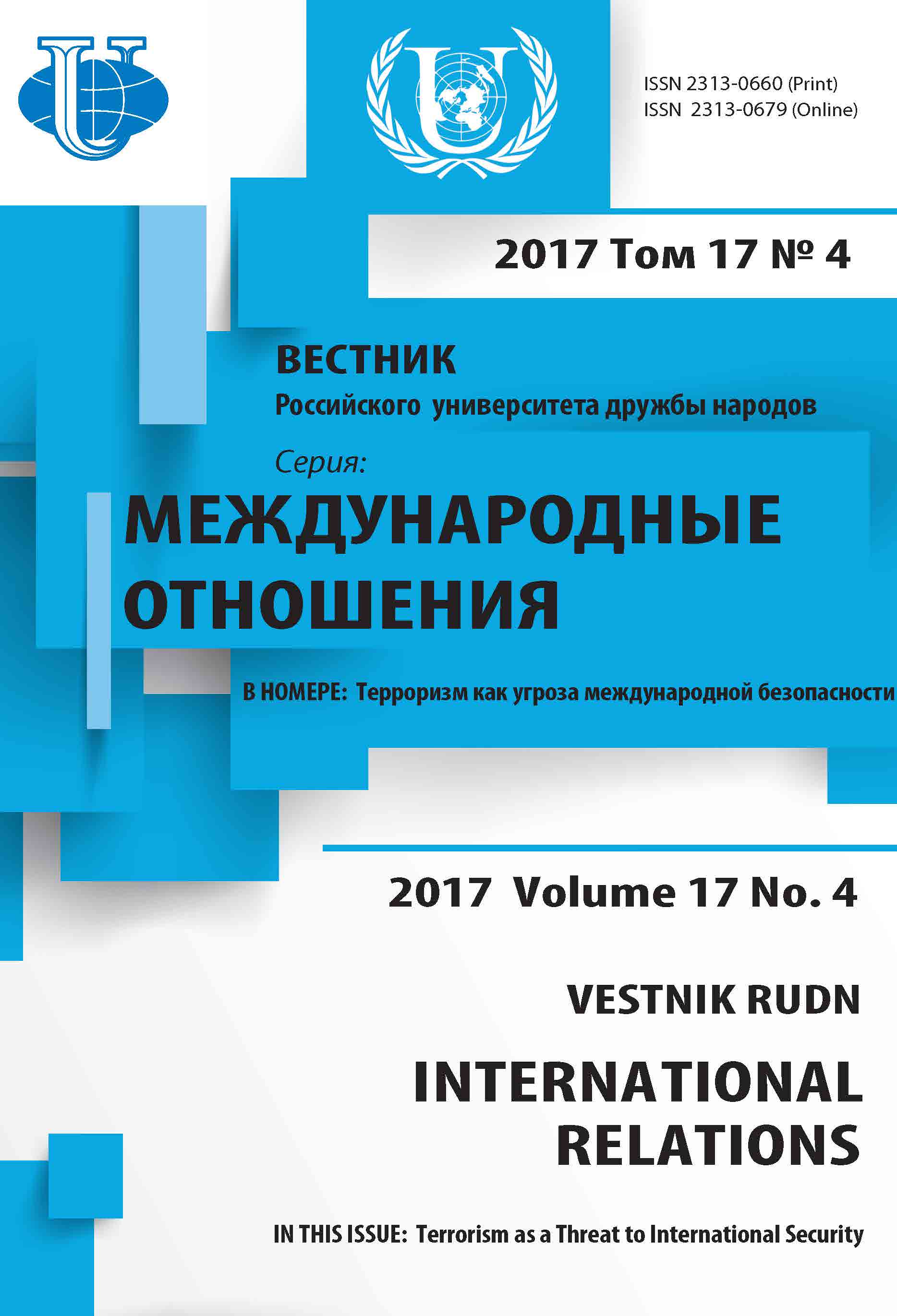THE INFLUENCE OF EXTERNAL FACTORS ON THE DEVELOPMENT OF SEPARATISM IN XINJIANG OF PRC
- Authors: Mavlonova AS1
-
Affiliations:
- The National Research University “Higher School of Economics”
- Issue: Vol 17, No 4 (2017): Terrorism as a threat to international security
- Pages: 770-780
- Section: PEACE AND SECURITY
- URL: https://journals.rudn.ru/international-relations/article/view/17535
- DOI: https://doi.org/10.22363/2313-0660-2017-17-4-770-780
- ID: 17535
Cite item
Full Text
Abstract
The article considers the important geostrategic position of Xinjiang, located at the in-tersection of foci of instability, at least having a common border with Afghanistan and Pakistan. The large-scale military conflict in the Middle East has definitely influenced the geostrategic posi-tion of Xinjiang. The analysis shows that the peculiarity of this conflict lies in the fact that it affects not only the political, but also the economic situation of Xinjiang. The aim of the study is to identify and analyze the main external factors that influence the activation of separatism in Xinjiang. As for the political aspect, the emergence of a new active force in the Middle East represented by ISIS creates certain risks for China, given the presence of radical young people, and the possibility of religious extremists from penetrating into its territory through Afghanistan and the Central Asian republics. China does not benefit from the prolonged destabilization of the political situation in Syria, the disintegration of the state or the victory of religious extremists. The author also comes to the conclusion that the military conflict in the Middle East can negatively affect the implementation of the project of the new Silk Road. Its starting point is Xinjiang. Successful implementation of the project will stimulate trade, economic and energy exchanges with the Central Asian republics and positively influence the stabilization of the situation in Xinjiang. But the problem lies in the fact that the road itself lies close to the Middle Eastern regions, where conflicts with the ISIS occur in the acute phase. The article also examines the US influence on the situation in Xinjiang and support for the Uyghur separatist movement. In the future, the Uyghur issue is more likely to be used by the Americans to weaken and gain concessions from China on various issues. This research is based on the principles of general scientific system and structural approaches, as well as structural and functional approaches; cultural-civilizational and logical methods in order to ensure the study of the problem in accordance with historical facts and realities of the issue under study.
Keywords
About the authors
A S Mavlonova
The National Research University “Higher School of Economics”
Author for correspondence.
Email: mavlonova.anna@yandex.ru
Mavlonova Anna Sergeevna - PhD in History, Senior Lecturer of the School of Asian Studies, Faculty of World Economy and International Affairs of National Research University Higher School of Economics
References
- Antipov, K.V. (2015). The economic corridor “China-Pakistan” opens the Silk Road to the West. Istoriya i sovremennost’, 20, 260—272. (in Russ.).
- Chaudhuri, D. (2010). Minority Economy in Xinjiang—A Source of Uyghur Resentment. China Report, 46 (1), 9—27. Chen, Zh. (2016).
- China Debates the Non-Interference Principle. Chinese Journal of International Politics, 9 (3), 349—374.
- Clarke, M. (2016). ‘One Belt, One Road’ and China’s emerging Afghanistan dilemma. Australian Journal of International Affairs, 70 (5), 563—579.
- Dubrovskaya, D.V. (1998). The fate of Xinjiang. Moscow: Institute of Oriental Studies, Russian Academy of Sciences. (in Russ.).
- Krivopalov, A.A. (2016). Chinese military power as a new factor in world politics. Moscow: Nauchnyi ekspert. (in Russ.).
- Kumar, S. (2012). China’s Grand Strategy, Kashmir and Pakistan: Transformation of Islamabad from a Spoiler State to Frontline State for Beijing. Journal of Siberian Federal University. Humanities & Social Sciences, 8, 1200—1217.
- Nadtochei, I.V. (2014). Islamic Movement of Eastern Turkestan: history, evolution, dynamics of terrorist activity. Puti k miru i bezopasnosti, 2 (47), 28—54. (in Russ.).
- Naumov, A.O. (2014). “Color revolutions” in the post-Soviet space: a view ten years later. Public administration, 45, 148—176. (in Russ.).
- Nie, H. (2009). Explaining Chinese Solutions to Territorial Disputes with Neighbor States. Chinese Journal of International Politics, 2 (4), 487—523.
- Rudel’son, Dzh. (1994). Uygurs and the future of Central Asia. World Economy and International Relations, 8—9, 98—112. (in Russ.).
- Small, A. (2015). The China-Pakistan Axis: Asia’s New Geopolitics. New York: Oxford University Press.
- Syroezhkin, K.L. (2006). Problems of modern China and security in Central Asia. Almaty: Kazakhstanskii institut strategicheskikh issledovanii pri Prezidente RK. (in Russ.).
- Toops, S. (2016). Reflections on China's Belt and Road Initiative. Area Development and Policy, 1 (3), 352—360.
- Wallace, T. (2014). China and the Regional Counter-Terrorism Structure: An Organizational Analysis. Asian Security, 10 (3), 627—645.
- Yin, Zh. (2015). “Yidai yilu” de lishi fudan: fankong zhanzheng yu “zhengzhi yisilan” kunjing [Historical burden: the war on terror and the “political Islam” predicament]. Wenhua zongheng, 3, 36—47. (in Chin.)
- Yin, Zh. (2016). Kongbuzhuyi yu “shijie xin zhixu” shenhua de pomie [Terrorism and the Disillusionment of the Myth of “New World Order”]. Wenhua zongheng, 3, 52—60. (in Chin.)
- Yu, Q. (2016). China's Transport Infrastructure Investment: Past, Present, and Future. Asian Economic Policy Review, 11 (2), 199—217.
Supplementary files










